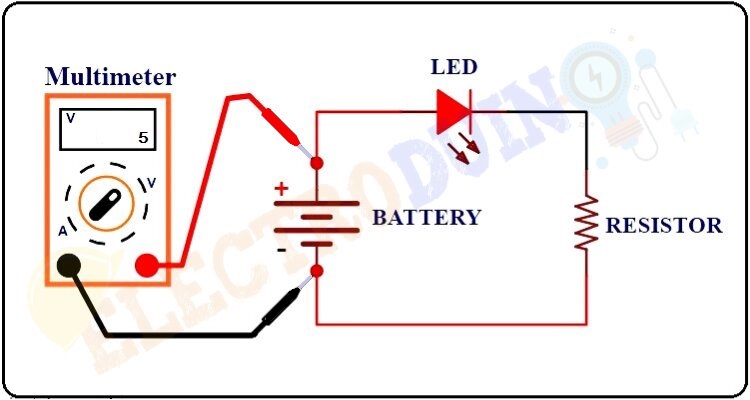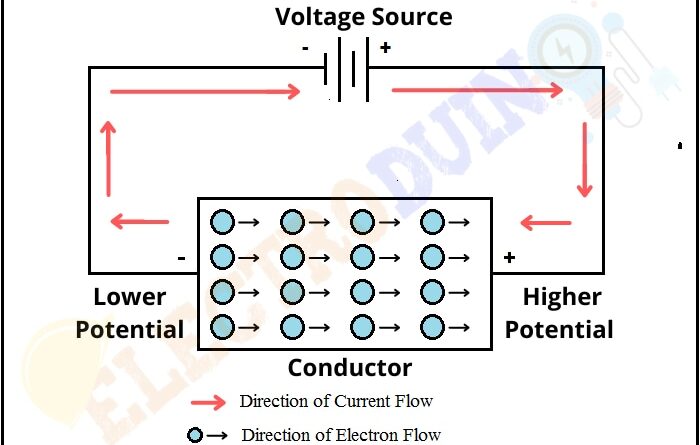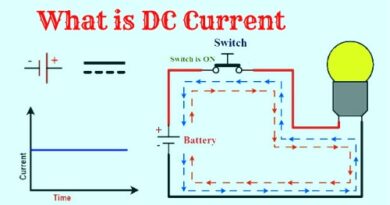Voltage or Potential Difference – Unit, Symbol, Formula
Hello friends! Welcome back to ElectroDuino. This blog is based on What is Voltage or Potential Difference. Here we will discuss what is Voltage or Potential Difference, Definition, Unit, Symbol, Dimension, and Formula.
What is Voltage or Potential Difference?
Voltage is the force or pressure that is responsible for pushing the charge or electrons to flow in a closed-looped electrical circuit. This flow of electrons (charge) is called the electric current. It is also defined as the difference in electric potential per unit charge between two points in an electric field. The greater the voltage the greater the current will flow through that point.
In simple words, we can say that the voltage is a potential difference between two points in an electric field that force or pressure electrons to move in a particular direction in the close loop circuit, which causes generating current.
If we connect a voltage source to a conductor. Then one end of a conductor becomes positive potential (higher potential) and another end becomes negative potential (lower potential). So, a potential difference creates between both ends of the conductor. Then the positive potential or higher potential end will attract the negative charges (Electrons) because unlike charges attract. As a result, the current flows through the conductor. The greater the attraction and the greater the current flow.
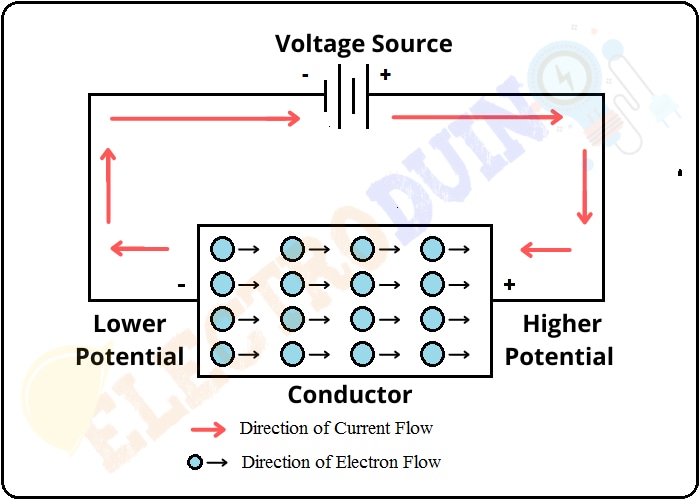
Voltage can be express as, the work required to move per unit of charge between two points in a static electric field. Mathematically, it can be expressed as,

Voltage is also known as electric potential difference, electromotive force (EMF), electric pressure, or electric tension.
Unit of Voltage or potential difference
The SI unit for voltage or potential difference is volts, which is represented by the letter V. The Italian physicist Alessandro Volta (1745-1827), who invented the first electrical battery voltaic pile, the unit volt is named in honor of them.
Definition of one Volt (1V): If one joule of work is done to move one coulomb of charge from one point (lower potential) to other (higher potential) in an electric circuit, the potential difference between these two points is known as One Volt (1V).
Mathematically, One Volt (1V) can be expressed as

So, volt can be expressed in terms of SI base units as Kg m2 s-3A-1
Dimensions Formula

Types of Voltages
Based on the direction of charge flow, the voltage is classified into two types – AC voltage and DC voltage.
AC Voltage: In this type of voltage, the flow of electric current changes its direction periodically. For this reason, this type of voltage source changes its polarity periodically. It can generate by an alternator. This type of voltage is widely used in industrial and residential applications. AC voltage source has no fixed polarity, the AC voltage Source symbol shown below

DC Voltage: In this type of voltage the flow of electric current in only one direction (uni-directional). It has fixed polarity. It is mainly generated by batteries, solar cells, fuel cells. Most electronic devices like, computers, TV, phones, satellites all are work on DC voltage. DC voltage source has two fixed polarities, positive or anode (+) and negative or cathode (-), the DC voltage Source symbol shown below

Voltage Formula and Calculations
There are three different basic formulas that can be used to calculate the voltage in the circuit. Below the figure is the Voltage Formula Triangle, which shows the relation between Voltage(V), Current (I), Resistance (R), and Power (P).
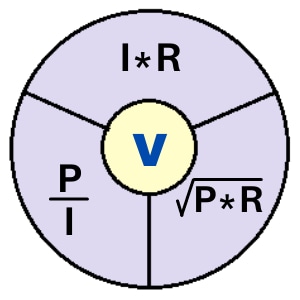
Formula Type 1 (Ohm’s Law)
Ohm’s Law describes the relationship between voltage, current, and resistance in an electrical circuit. According to Ohm’s law, Voltage can be mathematically expressed as,
Voltage = Current x Resistance
V = I*R
Where, V = Voltage, I = Current and R= Resistance
Example: Using a basic example let’s explain how to calculate the voltage drop across a circuit.
Question: If in a circuit (figure shown below) a current of 2 A is flowing through the resistance of 20 Ω. Calculate the voltage drop across the circuit.

Solution:
Given Data: Current (I) = 2A, Resistance (R) = 20 ohm
According to ohm’s law,
V = I * R
V = 2 x 20 = 40 Volt
Thus, by using the equation we get voltage drop across the circuit 60 Volts.
Formula Type 2 (Power and Current)
This formula expresses the relationship between voltage, Power, and current in an electrical circuit. The power transferred is the product of supply voltage and electric current flow in a circuit. Mathematically, it can be expressed as
P = V * I
So, from the above equation, we get the voltage equals the power divided by current, mathematically,
V=P/I
Example: Using a basic example let’s explain how to calculate supply voltage in a circuit.
Question: If in a circuit a current of 2 A is flowing through a lamp of 100 W. Then calculate the supply voltage of the circuit.
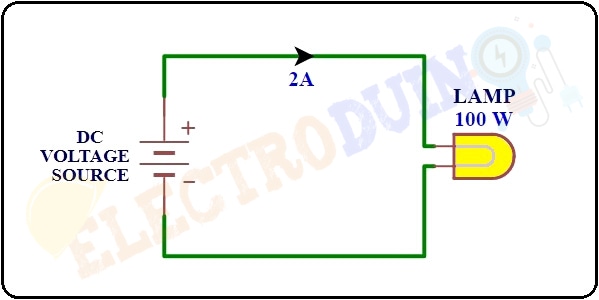
Solution:
Given Data: Current (I) = 2A, Power (P) = 100 W
According to the Formula,
V = P/I
V = 100 / 2 = 50 Volt
Thus, by using the formula we get the supply voltage to the circuit is 50 Volts.
Formula Type 3 (Power and Resistance)
This formula expresses the relationship between voltage, Power, and Resistance in an electrical circuit.
We know that,
Power = Voltage * Current
P = V * I
According to ohm’s law, now put I=V/R in the above equation we get,
P = V2/R
So, Voltage is the square root of the product of power and resistance. Mathematically, it can be expressed as
V = √P * I
Example: Using a basic example let’s explain how to calculate the necessary voltage to glow a lamp in a circuit.
Question: Calculate the necessary voltage to glow 5 W, 2 Ω lamp in the circuit.

Solution:
Given Data: Resistance (R) = 2 ohm = 2A, Power (P) = 5 W
According to the Formula,
Voltage (V) = √P * I
V = √5 * 2 = √10 = 3.16 Volt
Thus, by using the formula we get the necessary voltage to glow 5 W, 2 Ω lamp is 3.16 Volts.
How to Measure Voltage
The voltage or Potential difference is measured by a voltmeter. An instrument that can measure the voltage between two points in a circuit is known as Voltmeter. To measure voltage in a circuit, a voltmeter must be connected in parallel with the component.
For example, a circuit consists of a LED (Light emitting Diode), a resistor, and a DC voltage source (battery). If we need to measure the voltage of the battery, then we need to connect the voltmeter in parallel with the battery, as shown in the below figure
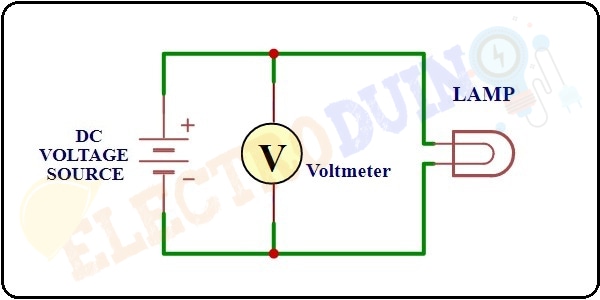
Also, the voltage can be measure using a multi-meter. A multi-meter must connect in parallel with the component, whose voltage is to be measured. As shown in the below figure.
